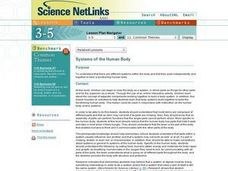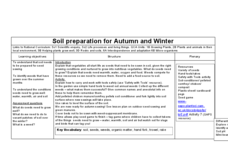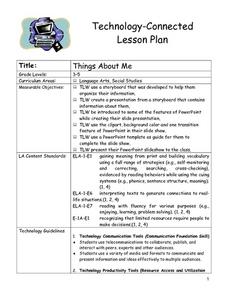Curated OER
Biology: Systems of the Human Body
Students examine the different systems of the human body and how they work independently and cooperatively. They complete sevral online interactive projects designed to reinforce how the systems work alone and together. Students make...
Curated OER
Rolling in Dough
Students demonstrate how to work cooperatively in groups. In this philanthropy lesson, students work cooperatively to create play dough and are rewarded time to play with the play dough cooperatively.
Curated OER
Soil Preparation for Autumn and Winter
Students determine how and why soil needs to be prepared for the fall and winter seasons. In this agriculture lesson, students determine how to use gardening tools safely. They show how to work with compost material and fertilizer to...
Curated OER
Seeing is Believing
Young scholars participate in a visualization exercise and explore the concept of visualization and how it works. They read from the book, 'Freckle Juice' and try to visualize what is happening so far. They draw the main character in the...
Curated OER
Guess What?!
Students explore how scientists work. In this scientific method activity, students use their senses to identify objects they cannot see. Students are asked to think like scientists and make observations, comparisons, and interferences,...
Curated OER
Farm Animals: blind folded
Students yell out their farm animal noise while being blind folded and have to find their animal group. In this group activity lesson plan, students learn how to work together to achieve a common goal.
Curated OER
Energy Resources Scavenger Hunt
In this environment worksheet, students complete each of the statements with its correct energy resource. They identify and name various types of plants and rocks. Students also identify and explain how fertilizer works and how it can be...
Curated OER
The Differences Between Turtles and Tortoises
First graders differentiate between turtles and tortoises. In this turtles and tortoises lesson students are visited by a turtle and a tortoise. Students write a letter with an illustration after the animals visit the class.
Curated OER
Things About Me
Students watch as the teacher explains how to use a storyboard to plan a PowerPoint presentation. They examine how to use clip art, background colors, and at least one transition before creating a PowerPoint presentation according to the...
Curated OER
Investigation 3 - Weighty MistakesStudents
Third graders investigate levers and the concept of work.
Curated OER
Lesson Plan: Breaking the Rules
Breaking the rules isn't always a bad thing, sometimes it pushes the boundaries of the imagination. Young art enthusiasts examine the Kevin Red Star piece, Knows Her Medicine Crow Indian. They analyze how the artist broke rules during...
Calvin Crest Outdoor School
Survival
Equip young campers with important survival knowledge with a set of engaging lessons. Teammates work together to complete three outdoor activities, which include building a shelter, starting a campfire, and finding directions in the...
Curated OER
Recycling and Composting
Students set up composting sites that allow food scraps and paper to be recycled by nature. They are introduced to one aspect of recycling; composting. Students see how God recycles as the worms change garbage into something that brings...
Curated OER
The Value of Education
Money is always a great motivator. Give the class a set of statistics regarding yearly annual wages with the corresponding level of completed education. Even if they think college is silly, they'll consider it when they realize how much...
Curated OER
Noncombatancy and the Seventh day Adventist Church
Upper graders investigate how the Seventh Day Adventists are objectors to the practice of war. The lesson covers the Civil War and examines the church's position about the practice of war. The research extends to modern wars and learners...
American Museum of Natural History
Making a Field Journal
Trowels and brushes are certainly important tools for an archaeologist working on a dig. Perhaps more important, however, is the archaeologist's field journal. Christina Elson, an archaeologist working with the American Museum of Natural...
Curated OER
Harmony Day - Driven Out
Children explore what life might be like for refugees and people migrating to a different country. Each student lists the five most precious items he/she owns and is then given an extreme scenario to consider. By the end of the exercise,...
Curated OER
Pollution and Lung Health
Students investigate how pollution affects lung health. In this pollution and lung health lesson plan, students build lung models from a soda bottle and balloons, and then discuss how the emissions from fossil fuels can adversely affect...
Curated OER
Remember This?
Students investigate the mechanics of an fMRI and the properties of neurons. In this biology lesson, students analyze the way the brain works by performing tests in the neurons in the brain. This is all done theoretically.
ARKive
Marvellous Mini-beasts – Design a Species
Here is a creative activity that teaches kids how species evolve different characteristics for survival. The lesson begins as the class discusses and examines the adaptive traits of mini-beasts or insects. Then, in small groups, they...
Mathematics Vision Project
Geometric Figures
Logical thinking is at the forefront of this jam-packed lesson, with young mathematicians not only investigating geometric concepts but also how they "know what they know". Through each activity and worksheet, learners wrestle with...
Curated OER
Maurice Sendak's Books: More Relevant and Rigorous than Ever
Nearly 50 years after publication, Sendak's Where the Wild Things Are holds up to the Common Core.
American Museum of Natural History
What Do You Know About Genetics?
Just what do you know about genetics? The online resource contains 10 questions about genetics. Scholars work through the questions ranging from what DNA stands for to how much of human DNA is similar to that of a fruit fly. Scholars...
Curated OER
One Step At a Time
Young scholars examine cultures in Africa. They discover culture includes behaviors, customs and actions. They examine how different people interpret things differently and practice seeing a situation from two points of view.
Other popular searches
- How Things Work Lenses
- How Things Work Toaster
- Explaining How Things Work
- How Things Work" Odometer
- Explanation How Do Things Work
- How Things Work Odometer
- "How Things Work" Odometer

























